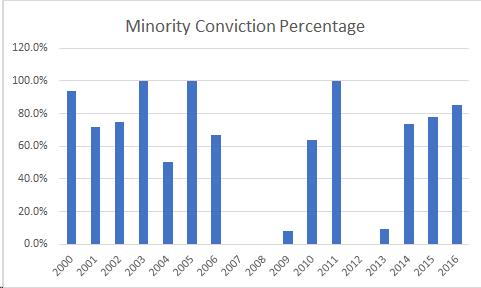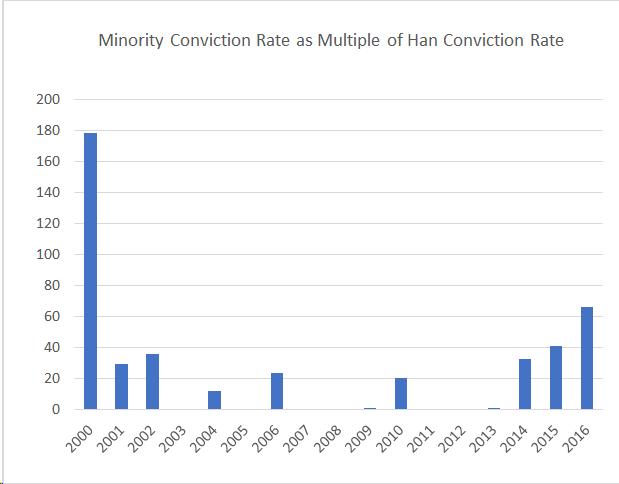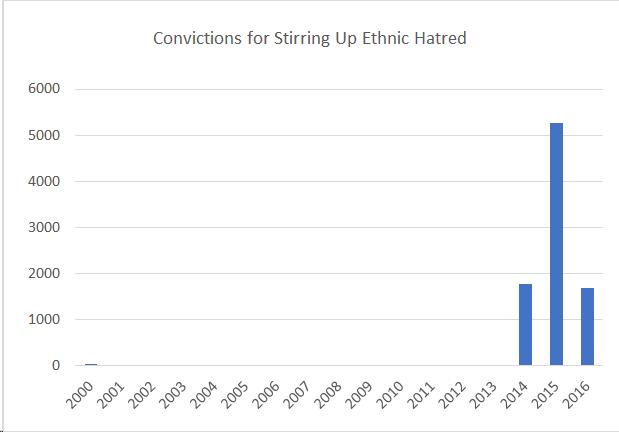Not surprisingly, ethnic minorities are convicted of the crime of stirring up ethnic hatred at a far higher rate than Han—not counting some outliers, usually 20 to 40 times as often, adjusted for population. The real shocker is the absolute numbers: typically in the single or low double digits from 2001 to 2013, and then leaping up to four digits in the next three years, reaching over 5,000 in 2015.
This is the second installment of some discoveries I’ve made looking through a multi-volume collection of Chinese court statistics. (First installment here.) In this installment, I look at convictions for the crime of stirring up ethnic hatred (煽动民族仇恨).
Nobody will be shocked to learn that those convicted of this crime are almost always members of one of China’s ethnic minorities. From 2000 (the first year in which conviction statistics appear) to 2016, the percentage of convicts who were ethnic minorities is usually well over two thirds. (Apologies for the graph; data is missing for some years, and I can’t get rid of the extension of the Y axis to 120%.)
But of course things are actually more extreme, because you need to adjust for population size. Let’s look at the conviction rate: how much more likely is a member of an ethnic minority to be convicted of this crime than a Han? Here, the year 2000 was evidently quite an outlier, but generally we see that minorities are convicted at about 20 to 40 times the rate that Han are convicted. Note also, though, that the rate has increased sharply from 2014 to 2016. (I’m not comparing those years to earlier years, for reasons I’ll explain below.)
Something very weird happens in 2014—so weird that it’s hard to show on a graph, because the numbers you have to fit into one graph are on totally different scales. From 2001 to 2013 (I’m not counting the apparently aberrational 2000, which had 48 convictions), the number of convictions was in the single or low double digits: 3, 4, 11, 12, that kind of thing. Being so low, they jumped around a lot, and it would be dangerous to infer any trends from them. But in 2014, the number of convictions goes from 11 the year before to 1,786. And in 2015, it shoots up even more to 5,265. These are not typos. And there were 1,693 convictions in 2016.
Here’s the same graph using a logarithmic scale on the Y axis; it shows the original data better:
What’s going on? I have no idea and would welcome readers’ thoughts. It would seem that some policy decision was made to take prosecutions under this heading to the next (and the next, and the next) level. A vast number of actions that had never previously been considered to constitute this crime now counted and presumably still count.
If I wanted to be snarky, I would conclude by noting that ethnic hatred in China seems to be almost entirely a failing of minority ethnicities, and one of which Han are almost entirely innocent. If I wanted to be snarky.
For those who want to play with the original data, here it is. I had to infer minority populations from numbers from the 2000 and 2010 census, and then use the percentages in those years for other years in which only the number for total population was available. Not perfect, but the best I could do.




To put this in context, in 2018/19, there were 103,379 hate crimes recorded by the police in England and Wales out of a population of sixty million.
The point that ethnic minorities are being unfairly targeted in China is well made, but the actual numbers seem tiny for China, with several hundred million members of ethnic minorities.
Thanks for the comment. I’m afraid I don’t think your numbers provide context, though, because they are simply not comparable. As I understand the term, in England “hate crime” means an ordinary crime motivated by hate, for which there is some kind of sentencing enhancement. (https://www.citizensadvice.org.uk/law-and-courts/discrimination/hate-crime/what-are-hate-incidents-and-hate-crime/). That is not at all what “stirring up ethnic hatred” as a crime in China is about.
Second, my guess is that the typical perpetrator of a hate crime in England is a member of the majority ethnic group, perpetrating it against a member of a minority. In China, those convicted of this crime are usually members of a minority ethnic group (and virtually always, when adjusted for population), and there is no individual victim. The crime is used politically. It doesn’t protect minorities; it selectively attacks them.
Third, the numbers don’t reflect anything but recorded convictions. They don’t reflect actual incidents or social reality. The vast increase in 2014 doesn’t reflect that persecution of minorities suddenly increased 162-fold. It does reflect something, but I’m not sure what. It reflects (among other things) a decision to use this label more frequently, or perhaps a decision to report the use of this label more frequently.